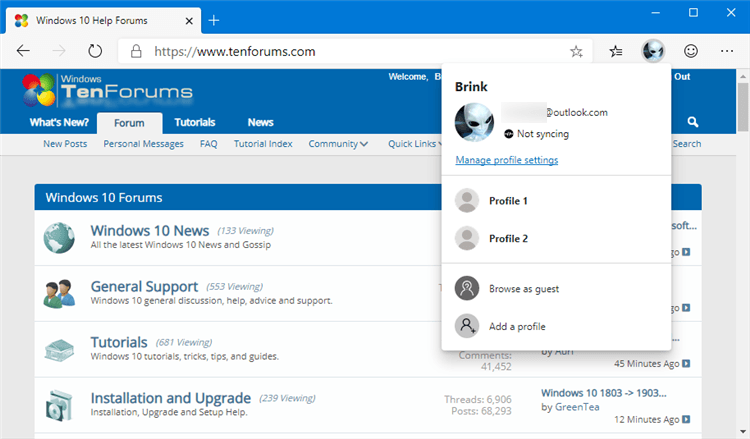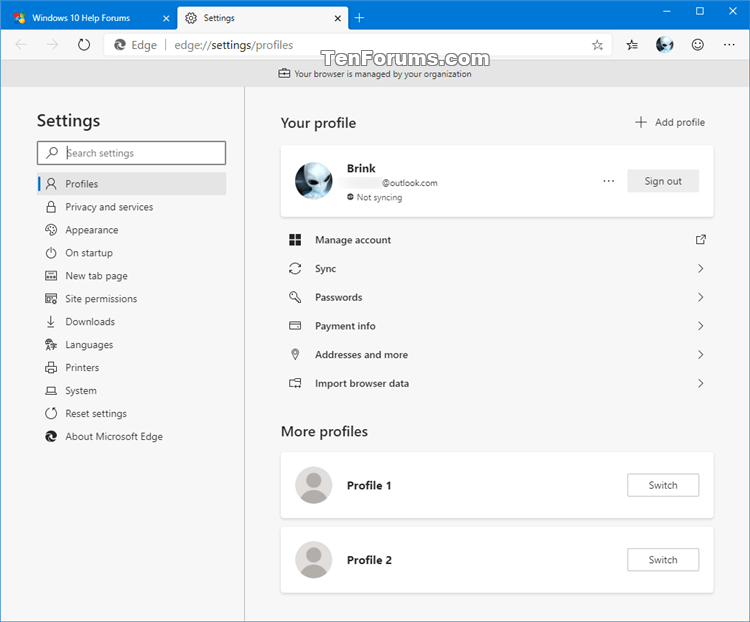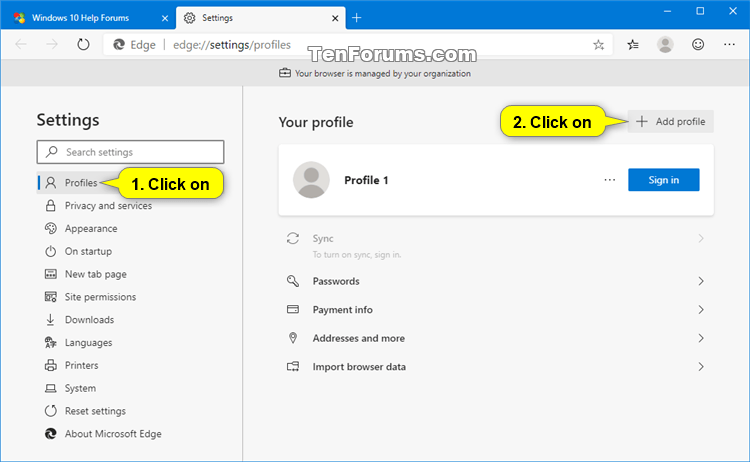How to Add a Profile in Microsoft Edge Chromium
Microsoft has adopted the Chromium open source project in the development of Microsoft Edge on the desktop to create better web compatibility. This new Microsoft Edge runs on the same Chromium web engine as the Google Chrome browser, offering you best in class web compatibility and performance.
The new Chromium based Microsoft Edge is supported on all versions of Windows 7, Windows 8.1, Windows 10, Windows Server (2016 and above), Windows Server (2008 R2 to 2012 R2), and macOS.
The Chromium based Microsoft Edge supports having multiple profiles. Profiles allow multiple users to operate in a shared environment while maintaining access to their personalized browser settings, bookmarks, and extensions.
You can sign in to a profile with your Microsoft account, your work/school account, or stay signed out of the profile for it to just be a local profile. When you sign in to a profile with a Microsoft account, you can turn on to have Microsoft Edge sync your history, favorites, passwords, and other browser data across all devices you are signed in to a profile in Microsoft Edge with the same account.
Profiles in Microsoft Edge allow you to separate your browsing data into independent profiles. Data associated with one profile is separate from data associated with other profiles. Your personal favorites and history, for example, are not synchronized with your work account if you set each up in different profiles. Profiles can also be useful if you wanted to share access to your Microsoft Edge browser with another user (ex: family member), or to keep your work and personal browsing separate.
However, users are able to easily switch between existing profiles in Microsoft Edge without the need for passwords. If users have access to the same device, users may create another profile on the same version of Microsoft Edge without the permission of the current profile owner. Removing the profile from Microsoft Edge settings permanently deletes browsing data for the specific profile stored on the device, such as browsing history, favorites, form fill data, and passwords. Data synced to your account may still be stored in the Microsoft cloud and may be cleared from the Microsoft privacy dashboard.
Guest mode is a temporary instance of a fresh profile. It allows you to browse on another user's device without modifying the signed-in profile. Browsing data from Guest mode such as favorites, browsing history, passwords, and form fill data does not persist after you close all Guest mode windows. Downloaded files are stored on the device, but the history of the downloads is deleted. Guest mode allows you to browse the web without being signed into other sites automatically. Microsoft Edge does not send websites any info to indicate that the user is browsing in Guest mode. When you use Guest mode, permission to collect diagnostic data about how you use the browser and websites you visit is taken from the profile of Microsoft Edge from which the Guest mode session was launched. All browsing data for the specific Guest mode session is cleared after all Guest windows are closed.
InPrivate browsing is a private browsing mode in which no browsing history, download history, cookies and site data, and form fill data are remembered. Microsoft Edge saves downloaded files as well as any new favorites created while browsing InPrivate. By default, while browsing InPrivate, Microsoft does not collect any info about websites you visit for product improvement purposes. Your school, workplace, or internet service provider may still be able to see your browsing activity. Browsing data for the specific InPrivate session is cleared after all InPrivate windows are closed. When using the Windows Input Method Editor (IME) keyboard for typing and inking, data may be collected to improve language recognition and suggestion capabilities. To stop inking and typing data from being collected by Microsoft while using the Windows IME keyboard in InPrivate and normal browsing windows, go to Start > Settings > Privacy > Inking & typing personalization.
Microsoft Edge will start you off with a single profile by default.
If you have more than one profile added in Microsoft Edge, you will be able to quickly switch between existing profiles.
If you have more than one profile added in Microsoft Edge, the Microsoft Edge icon on the taskbar will have the current profile's picture icon overlaid on it. This allows you to easily know which profile is used for that Microsoft Edge when opened if you would like to pin to taskbar multiple Microsoft Edge icons for different profiles.
See also:
- Sign in and create multiple profiles in Microsoft Edge | Microsoft Support
- Profiles | Microsoft Edge Privacy Whitepaper | Microsoft Docs
This tutorial will show you how to add one or more profiles to your Chromium based Microsoft Edge.
Profile folders (ex: "Default", "Profile 1", etc...) for Microsoft Edge are stored in the folder below:
(Stable Microsoft Edge)
%LocalAppData%\Microsoft\Edge\User Data
(Microsoft Edge Beta)
%LocalAppData%\Microsoft\Edge Beta\User Data
(Microsoft Edge Dev)
%LocalAppData%\Microsoft\Edge Dev\User Data
(Microsoft Edge Can)
%LocalAppData%\Microsoft\Edge SxS\User Data
Contents
- Option One: Add a Profile in Microsoft Edge from Profile Icon on Toolbar
- Option Two: Add a Profile in Microsoft Edge from Microsoft Edge Profiles Settings
EXAMPLE: Multiple profiles in Microsoft Edge

1 Open Microsoft Edge.
2 Click/tap on the Profile icon on the toolbar, and click/tap on Add a profile. (see screenshot below)
3 Click/tap on the Add. (see screenshot below)
4 A new Microsoft Edge window will open using this new profile. Click/tap on Sign in to sync data if you want to sign in to this profile with a Microsoft account or a work/school account. Otherwise, click/tap on Continue without signing in if you only want a local profile. (see screenshot below)
5 If you like, you can change the profile name and picture to anything you want.
1 Open Microsoft Edge.
2 Click/tap on the Settings and more (Alt+F) 3 dots menu icon, and click/tap on Settings. (see screenshot below)
3 Click/tap on Profiles on the left side, and click/tap on Add profile on the right side. (see screenshot below)
If you do not see a left pane, then widen the horizontal borders of the Microsoft Edge window until you do.
4 Click/tap on the Add. (see screenshot below)
5 A new Microsoft Edge window will open using this new profile. Click/tap on Sign in to sync data if you want to sign in to this profile with a Microsoft account or a work/school account. Otherwise, click/tap on Continue without signing in if you only want a local profile. (see screenshot below)
6 If you like, you can change the profile name and picture to anything you want.
That's it,
Shawn
Related Tutorials
- How to Enable or Disable Add Profile in Microsoft Edge Chromium
- How to Remove a Profile in Microsoft Edge
- How to Switch Between Profiles in Microsoft Edge Chromium
- How to Sign in and Sign out of Profile in Microsoft Edge Chromium
- How to Turn On or Off Sync for Profile in Microsoft Edge Chromium
- How to Change Name of Profile in Microsoft Edge Chromium
- How to Change Profile Picture in Microsoft Edge Chromium
- How to Change Default Profile to Open External Links in Microsoft Edge Chromium
- How to Turn On or Off Automatic Profile Switching in Microsoft Edge Chromium
- How to Enable or Disable Move Tabs to Different Profile window in Microsoft Edge Chromium
How to Add a Profile in Microsoft Edge Chromium

How to Add a Profile in Microsoft Edge Chromium
Published by Shawn BrinkCategory: Browsers & Email13 May 2021
Tutorial Categories


Related Discussions





